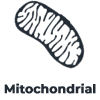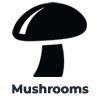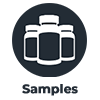After reading the above section, you may be wondering how we determined the Eurycomanone percentages, and if we really did the testing for those competitors. For the sake of transparency, which we believe is incredibly important in the supplement industry, we will now go over the testing methodology used, and the results of the analytical tests. It is complex, but also very interesting to dive into!
For Tongkat Ali, we are using High-performance thin-layer chromatography (HPTLC) testing. HPTLC is quite similar to HPLC, however, instead of using columns to separate compounds, HPTLC uses specialized plates called TLC plates. At its most basic, we have developed methods to dissolve all of the compounds in the Tongkat Ali samples into a solvent. We then spray this solvent onto a plate made of specialized silica gel. The compounds then travel up the TLC plate by means of capillary action. The separation occurring on the TLC plate is very similar to the separation happening in an HPLC column, like a C18. C18 stands for octadecylsilane, or 18 carbons bound to silicon dioxide. These silica-bound carbons stick out into the column and separate molecules from each other as they are pumped by at high pressures. In a TLC plate, you are essentially flattening out the column, and having the separation occur under normal air pressure, rather than being pumped at high pressure through a column. This capillary action is what spreads the different molecules across the plate, and separates them based on their polarity, which allows us to both identify and quantify each of the bands on the TLC plate.
If you want to see capillary action for yourself, find yourself some food coloring and put it in water. Now, take a piece of paper towel, and dip it into the food coloring solution, and slowly but surely you will see the colored liquid moving up into the paper towel. In the context of HPTLC, this capillary action separates the different compounds in Tongkat Ali by their polarity. Based on their polarity, different compounds in Tongkat Ali will travel up the TLC plates at different rates. This variation in how the various compounds in Tongkat Ali travel up the TLC plate is what separates the compounds from each other. This means that they will be deposited at different positions on the TLC plates. This may sound a little bit vague right now, but it is about to make a whole lot more sense because we can visualize it!
Once our TLC plate is ready, we can actually visualize where the compounds are on the plate. We do this by exposing the plates to UV and visible light, typically ranging from 190nm to 900nm. In our case, we used two wavelengths: one at 254nm and the second at 366nm. When we hit the plates with these wavelengths, the compounds on the plate either fluoresce or prevent fluorescence, allowing us to visually see where they are on the plate. This is very similar to the UV detector on an HPLC. So you can see how an HPTLC and HPLC are doing the same thing, just using different methods to do it. It’s about chromatographic separation of molecules, then detection using a UV detector. Let's take a look at the plate visualized with 254nm first:

All of the dark spots you see are where the compounds ended up due to the capillary action. The scale on the vertical axis are Rf values. An Rf value is the ratio of distance the compound travels on the Rf plate to the distance travelled by the solvent the compound is dissolved in. The Rf value then falls between 0 and 1. To simplify it, imagine you and three friends are doing a one mile running race with a time limit of 9 minutes. At the end of 9 minutes, your experienced running friend made it all the way to the one mile mark, whereas your other friends were scattered between 0.1 miles and 0.5 miles. One of your friends twisted his ankle at the 0.1 mile mark and didn’t make it much further. Another friend was pretty slow and could only make it to the 0.5 mile mark. You are also an experienced runner and tied with your friend at the 1 mile mark. These mile marks can be seen as Rf values, and these Rf values are being visualized on the TLC plate above.
If you check out the columns labeled 1 on the left, you can see those are our reference standards. The first column on the left is pure Eurycomanone from Chromadex, with a known concentration. The one on the right is the botanical reference material standard, which is also from Chromadex. Since the amount of eurycomanone in the leftmost lane is a known concentration, we can use that as our reference for the other samples. This is how we can quantify Eurycomanone in other samples accurately. As you can see, through capillary action, Eurycomanone made it up to Rf 0.65. When we visualize our TLC plate at 254nm, the entire plate fluoresces, hence the bright green color. At 254nm, Eurycomanone however does NOT fluoresce, and thus it shows up as a dark band. You can see this dark band in most of the samples we tested, indicating the presence of Eurycomanone. As you can see in our own 2% and 10% Eurycomanone extracts, the band with Rf value 0.65 are quite dark, and you can see that the 10% Eurycomanone Tongkat Ali extract is slightly darker than the 2% Eurycomanone Tongkat Ali extract. These bands are how we identify specific compounds in the extracts. We’ll get to how we quantify the exact amounts of Eurycomanone via HPTLC in just a second, but let's look at the plate that was exposed to a wavelength of 366nm first:

At 366nm, we see the reverse of the TLC plate that was visualized at 254nm. On this plate, only the compounds of interest fluoresce, and thus they show up as colorful bands on a dark background. As you can see, there is a band that fluoresces right around Rf value 0.65 on this plate as well. However, since we are using a different wavelength of light, and given the fact that Eurycomanone prevents the fluorescence, this is not actually Eurycomanone. You can see how the Eurycomanone reference standard in the leftmost lane doesn’t fluoresce at this wavelength. This is a sure indication that the band we are seeing in the Rf 0.65 region on the 366nm plate is something other than Eurycomanone. According to our research, this is likely a flavone that has yet to be elucidated in Tongkat Ali. This is based on the fact that it is fluorescing at 366nm and has an Rf value of 0.65. The interesting thing here is that two different compounds, due to similar polarities, both ended up at around Rf value 0.65. However, if we only visualized the plate at 254nm, then we would have only seen Eurycomanone and not the other flavone compound.
If we revisit our 1 mile race example that we discussed earlier, you and your experienced running friend both made it to the one mile mark in 9 minutes. This is easy to visualize, as we can visually see two different people at the 1 mile mark. In the case of HPTLC it is a little bit more complex, but by using different wavelengths of light, we can visualize two different compounds with the same Rf values. This is because different molecules will respond differently to various wavelengths of light. This is why it is oftentimes important to run a HPTLC test at different wavelengths, rather than just running it at one wavelength of light, as we may miss some potentially interesting compounds! So in this analogy, viewing race positions from one angle might allow an observer to see you standing at the one mile mark of the race, where looking at the positions from another angle allows them to see your experienced friend at the same one mile mark. Both you and your friend are standing at the same mark, just like Eurycomanone and this flavone are at the same Rf of 0.65 on the plate. Viewing them differently allows you to see the two things at the same place. So how can we empirically show this? We have to get further into the data. Take a look what we see when we zoom into the range of Rf 0.645.

You can see that we see a couple distinct peaks close to the Rf 0.65 region when we get further into the data. The peak that the red arrow is pointing at is Eurycomanone. The peak that the blue arrow is pointing to is the suspected flavone compound. Why do we think the peak by the blue arrow is a flavone? Benzene usually absorbs around 280nm, which is about where that peak is located. Flavones contain multiple benzene rings. So we are assuming that there is a flavone that is yet to be elucidated in Tongkat Ali that just happens to fall close to the same Rf value as Eurycomanone. If we only visually looked at the plates, we would not be able to tell the difference between the bands. However, our HPTLC software allows us to really get an accurate view of each band, and make determinations based on that data. That data explains why we see a band around the Rf 0.65 mark in both the 254nm and 366nm plates, even though Eurycomanone itself only shows up on the 254nm plate. You can see how the devil is in the details here. If you do not do a thorough job with your method development and validations, you can misinterpret or miss crucial factors in identifying and quantifying specific compounds.
Another interesting thing to note here is that on the 366nm TLC plate, we see a stronger fluorescence at around Rf value 0.65 for the 2% Eurycomanone Tongkat Ali extract than we see for the 10% Eurycomanone Tongkat Ali extract. In fact, there appears to be more fluorescence overall at 366nm for the 2% Eurycomanone Tongkat Ali extract than for the 10% Eurycomanone Tongkat Ali extract. The most likely explanation for this is that the 2% Eurycomanone Tongkat Ali extract is a more “full spectrum” extract. This means that it contains a larger percentage of the other compounds in Tongkat Ali besides Eurycomanone. Oftentimes when we are aiming for a high standardization of one specific compound, in this case Eurycomanone, it is at the expense of the other compounds in a plant. This means that the 10% Eurycomanone Tongkat Ali extract likely has a more focused effect that is more representative of pure Eurycomaone, whereas the 2% Eurycomanone Tongkat Ali extract is likely more representative of the whole root material. Overall, this results in the character of effects being different between the 2% and 10% Eurycomanone Tongkat Ali extracts. It is not simply the case that the 10% Eurycomanone Tongkat Ali extract is just 5 times more potent than the 2% Eurycomanone Tongkat Ali extract. Our goal was to maintain the ratios of the raw root as much as we could, and we have done a very good job of that. The 10% extract keeps many of the compounds you would find in the raw root. However, more potent extracts are inevitably going to concentrate some things, and lower others. This means that you will always have differing ratios of ancillary compounds between extracts that range in potency from each other. If we look at our extracts compared to a raw root botanical reference material, you can see what we are referring to.

Lane 7 is the botanical reference material of raw Tongkat Ali root from Chromadex. Lanes 8-11 are increasing concentrations of our 10% extract. Lanes 12-15 are increasing concentrations of our 2% extract. As you can see, we do a very good job of keeping the various compounds in the raw root intact. However, you can see that the bands in the 2% fluoresce differently, and are at different ratios/concentrations than the 10%. As we concentrate Eurycomanone, we inevitably change the ratios of the final product. This is also why we find more of that flavone compound at Rf 0.65 in our 2% extract, even though it has less Eurycomanone. This is one way to visualize why our 2% extract might feel different than our 10% extract, even if you tried to just increase the dose. You can see how we can use our analytical tools to get a very detailed view into our products, and exactly which compounds are in them.
It’s pretty clear that after seeing all this, getting exact numbers is definitely a complex science. Determining exact percentages of a given compound like Eurycomanone based solely on visual analysis is obviously not doable. Thus, these plates only allow us to visualize qualitatively that Eurycomanone is present, but it does not allow us to quantify exactly how much Eurycomanone is present. Remember how we mentioned the identification/quantification issue earlier? Luckily HPTLC generates a lot more data via its UV detector than just visual bands on a plate. As we mentioned before, this is very similar to how HPLC works. It’s all about chromatographic separation, identification, then quantification. Through computer software we can analyze the height of the peaks that are generated by the UV detector at specified Rf values. The peaks are analyzed for Absorbance Units (AU), and this is what allows us to quantify exact percentages. Fair warning, we are about to discuss a fair amount of math! Below is an example of this for sample SSF-266 which corresponds to competitor number 1 in our table above.


As you can see in the chromatogram above, peak number 4 is Eurycomanone. This matches the Rf value found in the Eurycomanone reference standard. We can then take this AU value and plug it into a calibration curve.

This calibration curves gets created by plotting the concentration of the reference standard against its AU value, then regressing the data. This can then be used to accurately quantitate subsequent samples. If your methods and measurements are valid, they will fall on the line connecting the various reference standard measurements. By using the calibration curve above, we can calculate the amount of Eurycomanone present in each sample. Check out the table below for our results for sample SSF-266 (competitor 1):

For sample SSF-266, our HPTLC test determined that it contains 53.70 micrograms of Eurycomanone per mL of solution. However, this number is not representative of the powder material, only of the sample as prepared, which is diluted for measurement purposes. With this in mind, we have to take into account the amount of dilution that took place while preparing the sample. This particular sample was created by dissolving 0.5116 grams of Tongkat Ali extract into 50 mL of our solvent. Using these data, we can calculate a dilution factor:
50 mL 0.5116 g = 97.733
Now we can determine how much Eurycomanone a pure, undiluted sample would contain:
53.70 μg/mL x 97.733 = 5248.262 μg/mL
We now need to convert this value into a percentage by mass. To do this, we can assume that 1 mL is equal to 1 gram, as is standard for diluting solids into liquids. With this in mind, we can convert our microgram per milliliter value into a gram per gram value. Below is the math used to get to this point:
5248.101 μg/mL 1000 μg/mg = 5.248101 mg/g
5.248101 mg/g 1000 = 0.005248101 g/g
Now that we have the concentration expressed in a Eurycomanone per total sample mass amount, we can easily convert it into a percentage by mass:
0.005248101 g/g x 100 = 0.5248101%
After running through these calculations, we can determine with a very high level of accuracy that sample SSF-266 contained 0.5248101% Eurycomanone, which rounds to 0.52%. While that may have gone over many people’s heads, we felt it was necessary to really get into the details behind the numbers. The amount of method development and validation work we do in the background would surprise many people. We want our numbers to be accurate. We want people to trust that when we make a claim, that claim is backed up by valid scientific proof. We feel that inaccurate or misleading numbers are worse than no numbers at all. Consumers trust science. However, when science is used improperly, or worse… to purposely mislead, it erodes people’s trust in valid scientific evidence. That is extremely dangerous. This is why we always ensure we are doing everything scientifically necessary to validate our chemistry, measurements, and calculations. You can see from our calibration curve that all our measurements fall within expected parameters, and our method results in a linear response at varying concentrations. This is a positive confirmation of assay performance, and shows that all our results are within a valid analytical range.









